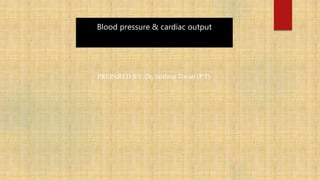
Bp pulse and cardiac output
- 1. Blood pressure & cardiac output PREPARED BY: Dr. Jaishree Tiwari (P.T)
- 3. • Upon completing this chapter students should be able to: 1.Define Blood pressure 2.Describe Pulse and Cardiac Output 3 Learning Objectives
- 4. BLOOD PRESSURE Blood pressure (BP) is a measure of the force that the circulating blood exerts against the arterial wall. 4 SYSTOLIC PRESSURE • Systolic pressure is the maximum pressure exerted by the blood against the arterial walls. • It results when the ventricles contract (systole )
- 5. 5 DIASTOLIC PRESSURE • Diastolic Pressure is the lowest pressure in the artery. • It result when the ventricles are relaxed (diastole ) Blood Pressure measurement •Office BP measurement: Two readings, 5 minutes apart, sitting. •Ambulatory BP monitoring: For white coat hypertension. •Self-measurement of BP: Information on response to therapy, may improve adherence to therapy. Time of measurement • Use multiple readings at different times during the waking hours of the patient. • For patient taking antihypertensive medications monitoring of blood pressure should be done before taking the scheduled dose.
- 6. 6 Patient position • BP should be measured in sitting position. Patient should sit for 5 minutes before measuring BP. • In elderly, supine and standing position can be used to detect postural hypotension. Selecting the most accurate blood pressure cuff • The length of the bladder should be at least 80% of the circumference of the upper arm. • The width of the bladder should be approximately 40% of the circumference of the upper arm.
- 7. 7Where to listen for blood pressure sounds 1- Locate the antecubital fossa of the patient’s arm and palpate the brachial artery. This location is the point over which the stethoscope is placed to listen for Korotkoff sounds later. 2-Wrap the cuff approximately 2.5 inch above the antecubital fossa.
- 8. 8Determining the palpated systolic pressure and the maximum inflation level 3. While palpating the radial pulse, inflate the cuff until you feel the radial pulse disappear. Note the pressure on the manometer at this point and rapidly deflate the cuff.
- 9. 9Measurement of BP 4- Place the stethoscope lightly over the brachial artery and inflate the cuff to a pressure 30 mm Hg greater than estimated systolic pressure. 5- Deflate the cuff slowly at a rate of 2 mm Hg per heartbeat. 6- Systolic pressure equal the pulse first heard by auscultation 7- Deflate the cuff until the sounds become muffled and then disappear.The disappearance of sound estimate the diastolic pressure. 8- Record the blood pressure reading in even numbers. Note patient’s position, cuff size, and arm used for measurement.
- 10. 10
- 11. CARDIAC OUTPUT Cardiac output is defined as amount of blood pumped out of each ventricle per minute. Cardiac output is expressed in two forms, 1)stroke volume 2) minute volume Unit – litre (ml) / min 11
- 12. 12CO = SV x HR cardiac output = stroke volume X heart rate (ml/minute) (ml/beat) (beats/min) a.Average heart rate = 70 bpm b.Average stroke volume = 70−80 ml/beat c.Average cardiac output = 5000 ml/minute Cardiac output varies widely with the level of activity of the body. FACTORS EFFECTING CARDIAC OUTPUT Heart rate When heart rate increases ,cardiac output also increases. Any factor which changes heart rate will also changes cardiac output. Force of contraction of heart When the force of contraction of the heart increases, stroke volume will increase. Therefore cardiac output will increase. Blood volume When blood volume increases cardiac output increases. Venous return
- 13. 13
- 14. STROKE VOLUME Stroke volume ( SV ) is the volume of blood pumped out of each ventricle per beat or contraction . As the stroke volume increases the cardiac output also increases. Stroke Volume depends upon 1. End diastolic Volume 2. Contractility SV = EDV – ESV 14
- 15. 15The stroke volumes for each ventricle are generally equal, both being approximately 70 ml in a healthy 70 kg man. Men, on average, have higher stroke volumes than women due to the larger size of their hearts. Physiological variations of cardiac output 1. Age: Cardiac output is more in adults than in children because blood volume is more. 2. Gender: cardiac output is more in male than females. 3. Altitude: cardiac output increases at high altitude places. 4. Pregnancy: cardiac output increases during pregnancy 5. Exercise: cardiac output increases during exercise 6. Emotion: cardiac output increases during emotional expressions.
- 16. 16 PATHOLOGICAL VARIATION OF CARDIAC OUTPUT Pathological increase: 1. Hyperthyroidism 2. Fever Pathological decrease: 1. Hypothyroidism 2. Hypovolemia 3. Haemorrhage 4. Myocardial infarction MEASURING CARDIAC OUTPUT 1. The Fick principle 2. Dilution methods 3. Pulmonary artery thermo dilution (trans right- heart Thermo dilution) 4. Doppler ultrasound method 5. Impedance cardiograph
- 17. RELATIONSHIP WITH BP As Cardiac output is made up of heart rate and stroke volume - at rest these are relatively constant. With exercise the heart beats faster - more blood is pumped out with each beat contributing to a rise in BP. Changes in the volume of blood within the cardiovascular system will also affect Bp. 17
- 18. 18 A person was severely dehydrated or lost a large quantity of blood through a wound, there would be less blood for the heart to pump, thereby reducing cardiac output and BP. For a typical, fit young person, the cardiac output might go up to about 20 litres/min at the peak of exercise. For a world-class athlete in an endurance sport, the maximum cardiac output might be around 35 litres/min. REGULATION OF CARDIAC OUTPUT It means maintaining a constant cardiac output around 5 litres/min under normal conditions and adjusting the cardiac output as per the physiological demands. It has to be regulated to have an optimum cardiovascular efficiency.
- 19. REFERENCES Reference Books : BD chaurasia Vol 3 anatomy https://teachmeanatomy.info/thorax/organs/heart/atria-ventricles/ 19